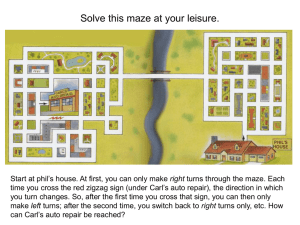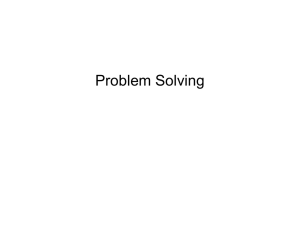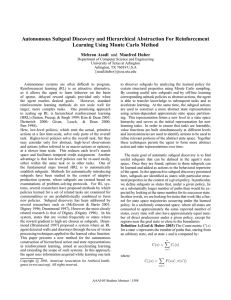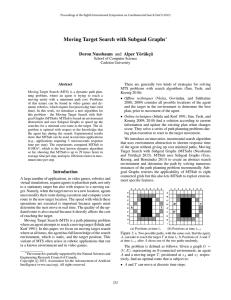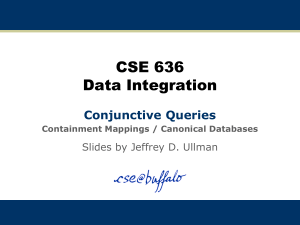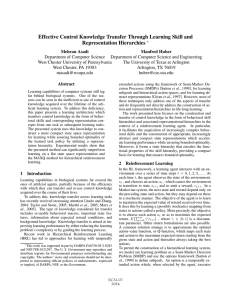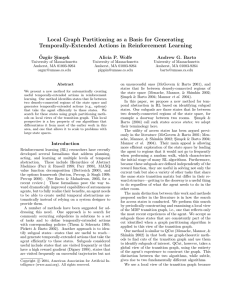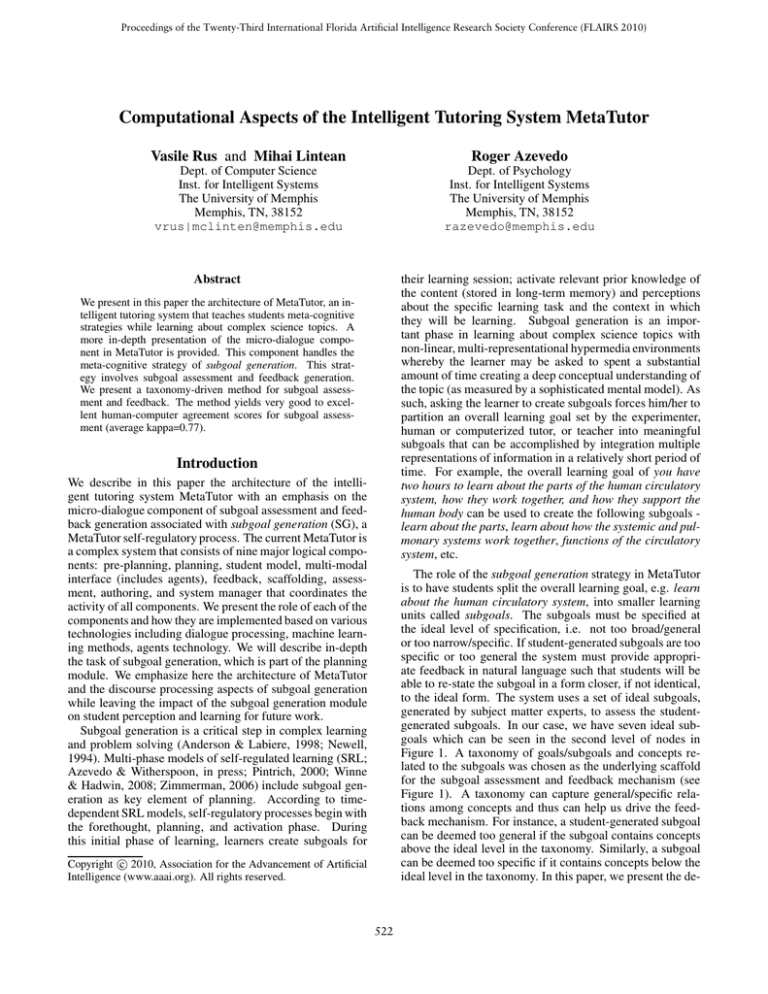
Proceedings of the Twenty-Third International Florida Artificial Intelligence Research Society Conference (FLAIRS 2010)
Computational Aspects of the Intelligent Tutoring System MetaTutor
Vasile Rus and Mihai Lintean
Roger Azevedo
Dept. of Computer Science
Inst. for Intelligent Systems
The University of Memphis
Memphis, TN, 38152
vrus|mclinten@memphis.edu
Dept. of Psychology
Inst. for Intelligent Systems
The University of Memphis
Memphis, TN, 38152
razevedo@memphis.edu
their learning session; activate relevant prior knowledge of
the content (stored in long-term memory) and perceptions
about the specific learning task and the context in which
they will be learning. Subgoal generation is an important phase in learning about complex science topics with
non-linear, multi-representational hypermedia environments
whereby the learner may be asked to spent a substantial
amount of time creating a deep conceptual understanding of
the topic (as measured by a sophisticated mental model). As
such, asking the learner to create subgoals forces him/her to
partition an overall learning goal set by the experimenter,
human or computerized tutor, or teacher into meaningful
subgoals that can be accomplished by integration multiple
representations of information in a relatively short period of
time. For example, the overall learning goal of you have
two hours to learn about the parts of the human circulatory
system, how they work together, and how they support the
human body can be used to create the following subgoals learn about the parts, learn about how the systemic and pulmonary systems work together, functions of the circulatory
system, etc.
Abstract
We present in this paper the architecture of MetaTutor, an intelligent tutoring system that teaches students meta-cognitive
strategies while learning about complex science topics. A
more in-depth presentation of the micro-dialogue component in MetaTutor is provided. This component handles the
meta-cognitive strategy of subgoal generation. This strategy involves subgoal assessment and feedback generation.
We present a taxonomy-driven method for subgoal assessment and feedback. The method yields very good to excellent human-computer agreement scores for subgoal assessment (average kappa=0.77).
Introduction
We describe in this paper the architecture of the intelligent tutoring system MetaTutor with an emphasis on the
micro-dialogue component of subgoal assessment and feedback generation associated with subgoal generation (SG), a
MetaTutor self-regulatory process. The current MetaTutor is
a complex system that consists of nine major logical components: pre-planning, planning, student model, multi-modal
interface (includes agents), feedback, scaffolding, assessment, authoring, and system manager that coordinates the
activity of all components. We present the role of each of the
components and how they are implemented based on various
technologies including dialogue processing, machine learning methods, agents technology. We will describe in-depth
the task of subgoal generation, which is part of the planning
module. We emphasize here the architecture of MetaTutor
and the discourse processing aspects of subgoal generation
while leaving the impact of the subgoal generation module
on student perception and learning for future work.
Subgoal generation is a critical step in complex learning
and problem solving (Anderson & Labiere, 1998; Newell,
1994). Multi-phase models of self-regulated learning (SRL;
Azevedo & Witherspoon, in press; Pintrich, 2000; Winne
& Hadwin, 2008; Zimmerman, 2006) include subgoal generation as key element of planning. According to timedependent SRL models, self-regulatory processes begin with
the forethought, planning, and activation phase. During
this initial phase of learning, learners create subgoals for
The role of the subgoal generation strategy in MetaTutor
is to have students split the overall learning goal, e.g. learn
about the human circulatory system, into smaller learning
units called subgoals. The subgoals must be specified at
the ideal level of specification, i.e. not too broad/general
or too narrow/specific. If student-generated subgoals are too
specific or too general the system must provide appropriate feedback in natural language such that students will be
able to re-state the subgoal in a form closer, if not identical,
to the ideal form. The system uses a set of ideal subgoals,
generated by subject matter experts, to assess the studentgenerated subgoals. In our case, we have seven ideal subgoals which can be seen in the second level of nodes in
Figure 1. A taxonomy of goals/subgoals and concepts related to the subgoals was chosen as the underlying scaffold
for the subgoal assessment and feedback mechanism (see
Figure 1). A taxonomy can capture general/specific relations among concepts and thus can help us drive the feedback mechanism. For instance, a student-generated subgoal
can be deemed too general if the subgoal contains concepts
above the ideal level in the taxonomy. Similarly, a subgoal
can be deemed too specific if it contains concepts below the
ideal level in the taxonomy. In this paper, we present the de-
c 2010, Association for the Advancement of Artificial
Copyright Intelligence (www.aaai.org). All rights reserved.
522
tails of our taxonomy-driven subgoal assessment and feedback model and report results on how well the system can
assess the student-articulated subgoals.
The rest of the paper is structured as follows. Previous
Work presents prior research on intelligent tutoring systems
with natural language interaction focusing on student input
assessment and dialogue management. Next, the architecture of the MetaTutor system is presented. The Subgoal
Generation section describes in detail our taxonomy-based
subgoal assessment and feedback generation method as well
as the experiments and results obtained. The Conclusions
section ends the paper.
misconception-expectation model in that we do have a set
of ideal/expected subgoals. However, our dialogue management method relies on a taxonomy of concepts to manage
the dialogue turns as opposed to a flat set of expectations or
misconceptions. There is need for a taxonomy because we
must identify general/specific relations in the student input
with respect to the ideal subgoals, as already mentioned.
The Architecture of MetaTutor
The current MetaTutor is a complex system that consists of
nine major logical components (see top part of Figure 2).
The implementation details of the system in terms of major
technologies used are shown at the bottom of the figure.
The architecture of the MetaTutor system is open; new
modules can be easily accommodated, and major changes
can be made to any of the existing modules without redesigning the system from scratch. For instance, if a more
advanced micro-dialogue manager is developed in the future then the current micro-dialogue manager component
can be replaced (in a plug-and-play manner) without affecting the functionality of the overall system, as long as the
interface with the other modules is maintained. If changes
to the interface with other modules are needed then such
changes must be propagated throughout the system to the
connected modules-but this is still less cumbersome than
redesigning from scratch. One other advantage of the current architecture is the decoupling of processing and data.
This feature allows easy transfer of MetaTutor from one
domain to another without changes in the processing part.
All the domain-specific information as well as other configurable information (e.g., the verbal feedback the agents
provide) is maintained in external, separate files that can be
easily edited by domain experts, dialogue experts, or cognitive scientists. The architecture is also reconfigurable in that
some modules can be turned on and off. To run a version
of MetaTutor without pedagogical agents (PAs) for comparison purposes and in order to evaluate the role of PAs
in self-regulated learning (SRL) modeling and scaffolding,
the Scaffolding module can turn off (not call) the Agents
Technologies implementation module and rely only on the
other modules for scaffolding purposes. For instance, it can
simply call the Multi-modal Interface module to display the
feedback the agents were supposed to utter.
We present next detailed descriptions of MetaTutors’
components. The pre-planning component collects student
demographic information, delivers a short quiz, and prompts
the student to activate prior knowledge in the form of a paragraph summarizing her knowledge on the topic to be studied, e.g., the circulatory system. In addition, pre-planning
calls other modules, such as the assessment module, to evaluate the quiz responses and the student-generated paragraph,
i.e., the prior-knowledge activation (PKA) paragraph. The
student model module is also called to update the model
based on the quiz results and evaluation of the PKA paragraph. The planning module handles the multi-step, mixedinitiative process of breaking the overall learning goal into
more manageable sub-goals. It relies on the micro-dialogue
manager module (see bottom part of Figure 2, Implementation Details), which handles the multi-turn interaction be-
Previous Work on Intelligent Tutoring Systems
with Natural Language
Intelligent tutoring systems with natural language input have
been developed at a fast pace recently (VanLehn et al. 2007).
We discuss prior research on assessment of natural language
student input and on dialogue management in intelligent tutoring systems because these two topics are most related to
our work presented here.
Researchers working on intelligent tutoring systems with
natural language input explored the accuracy of matching
students’ written input to a pre-selected stored answer: solution to a problem, misconception, or other form of benchmark response. Examples of these systems are AutoTutor
and Why-Atlas, which tutor students on Newtonian physics
(Graesser et al. 2005; VanLehn et al. 2007), and the iSTART system, which helps students read text at deeper levels (McNamara et al. 2007). Systems such as these have
typically relied on statistical representations, such as latent
semantic analysis (LSA; (Landauer et al. 2005)) and content word overlap metrics (McNamara et al. 2007). LSA
has the advantage of representing the meaning of texts based
on latent concepts (the LSA space dimensions, usually 300500) which are automatically derived from large collection
of texts using singular value decomposition (SVD), a technique for dimensionality reduction. However, LSA cannot
tell us whether a concept or a text fragment is more specific
or more general than the other, which is what we need to
handle subgoal generation student input in MetaTutor. We
rely on a taxonomy of concepts which explicitly embedds
specific/general relations among concepts or phrases.
Dialogue is a major component of the natural language
intelligent tutoring systems. Various dialogue management
models have been proposed in intelligent tutoring systems.
These models are usually built around instruction and human tutoring models. The dialogue models can be described
at various levels. For example, at one level the AutoTutor dialogue management model (Graesser et al. 2005) can
be described as a misconception-expectation model. That
is, AutoTutor (and human tutors for that matter) typically
has a list of anticipated expectations (good answers) and
a list of anticipated misconceptions associated with each
challenging question or problem in the curriculum script
for a subject matter. In this paper, we implement a microdialogue management model for providing feedback during
subgoal generation. Our model resembles at some extent the
523
The circulatory
system
Ideal level
Systems of
circulation
Lungs
Heartbeat
Heart
components
Aorta
Diastole
Systole
Systemic circulation
Veins
Valves
Arteries
Capillaries
Atria
Purposes
of the CS
Blood
components
Blood vessels
Anemia
Red BC
Stroke
Immune system
White BC
Hemoglobin
Malfunctions
of the CS
Blood clotting
Leukemia
Figure 1: Partial Taxonomy of Topics in Circulatory System
Figure 2: Overview of MetaTutor’s taxonomy
tween the system and the student. The purpose of this call
is to determine a set of accurate sub-goals. The planning
module calls other modules, such as the student model module, to update variables related to sub-goal generation that
are part of the student model. It calls the assessment module to assess each student-articulated sub-goal and then the
feedback module to generate appropriate feedback.
well as assessment of the PKA paragraphs and summaries of
content pages that students write. The student model module is called by other modules as they need to retrieve or
update information regarding students’ level of understanding of the subject matter and SRL behavior. The assessment module evaluates various student inputs (textual, actions on the interface, time-related behavior) and sends evaluation results to other components that need these results.
It uses information provided by the knowledge base module
and various functions provided by the natural language processing and machine learning modules (see Figure 2). For
instance, to assess a student-generated sub-goal the natural
language processing module is called with the sub-goal taxonomy, which is retrieved from the knowledge base, and the
student-articulated sub-goal as input parameters. The output
from the natural language processing module is a vector of
feature-values that quantifies the similarity between the stu-
The student model component maintains and updates
close to 100 variables that we deem important to assess
the students’ mastery of the subject matter (student mental model) and SRL processes (student SRL model). One
of the designing principles of the existing MetaTutor system
was to collect and store in log files everything that might
be related to shifts in understanding and SRL behavior in
students. Every attempt was made to create an exhaustive
set of variables to be tracked within the log files. Variables
include the scores on quizzes given throughout a session as
524
dent sub-goal and each of the ideal sub-goals in the taxonomy. The vector is then passed to a classifier in the machine
learning module that classifies the student-articulated subgoal into one of the following categories: too general, too
specific, or ideal (the more complex, hierarchical classification scheme is omitted here due to space constraints and to
keep the presentation simple).
The scaffolding module handles the implementation of
pedagogical strategies. It relies on the knowledge base,
XML parser, and production rules modules of the implementation architecture. The production rules encode conditions which are monitored by the system. Through a polling
mechanism, all the rules are checked at specified time intervals, e.g., every 30 seconds (this value will be calibrated
based on data), to see if the conditions of a rule are met.
When they are, the corresponding rule is triggered. If multiple rules fire simultaneously, a random or uniform policy
(implemented using a round-robin algorithm) can be implemented. The default policy in the current system is uniform
firing. The best policy is yet to be determined. The feedback
module handles the type and timing of feedback provided
through the PAs and other interface elements. It uses the
knowledge base, XML parser, and production rules modules in the implementation. The authoring module serves
the designer of the system, the subject-matter experts, and
the cognitive scientists that use the system. It relies on XML
editors and text editors to make changes to various configurable items in the knowledge base. The multi-modal interface module handles the complex interface between the
students/experimenter/developer and MetaTutor.
The system manager controls the operation of the entire system, assuring proper communication and sequencing
among all components. The Log module in the implementation view records every single action by the user and the system such that post-experiment analyses can be performed.
The knowledge base module includes the content pages and
other knowledge items needed throughout the system, such
as the sub-goal taxonomy used during sub-goal generation in
the planning module. The agents’ technology module handles the three agents we have used in MetaTutor: Mary the
monitoring agent, Pam the planner, and Sam the strategizer.
by extracting and comparing its key concepts, i.e. words or
sequences of words, with entries in the taxonomy. The assessment is performed using the following dimensions:
• Full or partial match. If all the key words that describe a
subgoal in the taxonomy are present in the student subgoal
then we have a full match. Otherwise, if only some of the
subgoal’s key words are present in the student’s input, a
partial match occurs.
• Single or multiple matches. When a student subgoal is
associated with more than one subgoal we have multiple
matches. That is, the student input points to two or more
different subgoals. An example of a multiple matches student subgoal is I would learn about heart valves. The
concept of valves is associated with the subgoals of heart
components and blood vessels (see Figure 1).
• Specific, general, or perfect match. An example of a
perfect match is when the exact concept in the taxonomy
is found in the student subgoal as in I want to know more
about blood vessels (major ones). This student subgoal
matches the ideal subgoal blood vessels. In other words,
the student subgoal is not too general, not too specific, and
it contains all and only the words of the subgoal concept
in the taxonomy. When a student subgoal only mentions
concepts below the ideal level (see Figure 1) in the taxonomy, the subgoal is deemed too specific. An example of
a specific student subgoal is I need to learn more about
veins. It is too specific because veins is below blood vessels, the ideal level, in the taxonomy.
• Relevant or Irrelevant. When a student subgoal does not
match any concept in the taxonomy we have an irrelevant
subgoal. Otherwise, we have a relevant subgoal.
Based on student subgoal assessment, a particular type
of feedback will be generated. The feedback is specific
to each combination of values for the above dimensions
of assessment, i.e. depending on whether the subgoal is
deemed a full or partial match, single or multiple matches,
specific or general or perfect match, and relevant or irrelevant. For instance, when a student-articulated subgoal is
deemed full match, relevant, too general, single match, then
the following multi-turn dialog will take place:
Subgoal Generation
Student: I want to learn about the circulatory system
System: Alright, can you be a little more specific about
what you would like to learn about the circulatory system?
Student: learn about the valves of the heart
System: That’s good, but it’s a little too specific level for
our objectives today. Let’s consider a broader sub-goal.
Did you want to learn about ’Heart components’ or ’Blood
vessels’?
Student: Heart components
System: Wonderful! We’ve just setup a good subgoal.
Please choose another subgoal.
An intelligent tutoring systems whose goal is to model and
scaffold subgoal generation should include a component
able of first assessing student generated subgoals and then
provide appropriate feedback to help the student set an ideal
set of subgoals.
In MetaTutor, a taxonomy-driven dialogue management
mechanism has been implemented to handle subgoal assessment and feedback generation (see Figure 3). We organized
hierarchically in a taxonomy the overall learning goal, its
seven ideal subgoals as identified by human experts, and
relevant keywords associated with each subgoal. In this
subgoal taxonomy (see Figure 1), the top node is the most
general while the leaves (lowest level nodes) are the most
specific. The taxonomy was semi-automatically generated
from the set of seven ideal subgoals and other sources such
as WordNet (Miller 1995). A student subgoal is assessed
For each system turn we have a list of generic templates
with placeholders for important items such as subgoals as in
the following example: Very good! Let’s try to set a subgoal
525
Generate
Subgoal 3
Generate
Subgoal 2
Generate
Subgoal 1
Start Reading
Content
Student
Generate Subgoals
Suggest
Subgoal(s)
Full Match
Enter subgoal
description
No
First Partial
Match?
Partial Match
Classify input
Yes
Student
Feedback to
try again
No Match
Suggest Subgoal
Ideal subgoal or
too specific
Type of Matched
Subgoals
Confirm
Subgoal(s)
Subgoal too general Feedback to
try again
2 or less
Subgoal already defined
#Times
at this point
More than 2
Suggest random
subgoal
Feedback to try again
2 or less
#Times
at this point
3
Tell student
to retry
First time here?
Yes
Show subgoals
example video
No
More than 3
Suggest random
subgoal
Figure 3: Overview of the Subgoal Generation process in MetaTutor
that covers ’Y’. How about we try to learn about ’X’. which
is used when a student-articulated subgoal (Y) is assessed as
full match, relevant, too specific, and single match.
subgoal fully specified. We compared the human judgments
with computer judgments and report the results, in terms of
kappa scores, in Table 1 for each individual subgoal and also
on average.
Results on Subgoal Assessment
To evaluate our subgoal assessment method, we have experimented with a set of 258 student generated subgoals collected from a classroom experiment in which students were
asked to generate 3 subgoals for the overall learning goal of
learning about the circulatory system. The generated subgoals were then rated by an expert with respect to which
ideal subgoals the student subgoal specified. The expert
used the following three scores to rate each student subgoal:
0 - subgoal not specified, 1 - subgoal partially specified, 2 -
Conclusions
We presented the architecture of the intelligent tutoring system MetaTutor that teaches students meta-cognitive strategies. Also, we described in more details the component of
subgoal generation including results obtained with the proposed taxonomy-driven method. The method yielded very
good human-computer agreement scores for subgoal assessment.
526
Graesser, A.C.; Hu, X.; and McNamara, D.S. 2005. Computerized learning environments that incoporate research in
discourse psychology, cognitive science, and computational
linguistics. In A. Healy (Eds.). Experimental Cognitive
Psychology and its Applications, 59-72. Washington, D.C.:
APA.
Greene, J.A.; and Azevedo, R. 2009. A macro-level analysis of SRL processes and their relations to the acquisition
of sophisticated mental models. Contemporary Educational
Psychology, 34, 18-29.
Kozma, R. 2003. The material features of multiple representations and their cognitive and social affordances for science
understanding. Learning and Instruction, 13(2), 205-226.
Landauer, T.; McNamara, D.S.; Dennis, S.; and Kintsch, W.
(Eds). 2005. Latent Semantic analysis: A road to meaning.
Mahwah, NJ:Erlbaum.
Mayer, R. 2005. The Cambridge handbook of multimedia
learning. NY: Cambridge University Press.
McNamara, D.S.; Boonthum, C.; Levinstein, I.B.; and Millis, K. 2007. Evaluating selfexplanations in iSTART: comparing word-based and LSA algorithms. Handbook of LSA.
In Landauer, T., D.S. McNamara, S. Dennis, and W. Kintsch
(Eds.). NJ: Erlbaum, 227-241.
Miller, G. 1995. Wordnet: a lexical database for english.
Communications of the ACM, 38(11):3941.
Mitchell, T. 1997. Machine Learning McGraw Hill.
Newell, A. 1994. Unified Theories of Cognition. Harvard
University Press.
Pintrich, P.R. 2000. The role of goal orientation in selfregulated learning. In M. Boekaerts, P. Pintrich, and M. Zeidner (Eds.). Handbook of self-regulation., San Diego, CA:
Academic Press, 451–502.
Rus, V.; McCarthy, P.M.; Lintean, M.; Graesser, A.C.; and
McNamara, D.S. 2007. Assessing student self-explanations
in an intelligent tutoring system. Proceedings of the 29th
annual conference of the Cognitive Science Society. In D. S.
McNamara and G. Trafton (Eds.).
VanLehn, K.; Graesser, A.C.; Jackson, T.; Jordan, P.; Olney,
A.; and Rose, C. 2007. When are tutorial dialogues more
effective than reading? Cognitive Science, 31(1):3–62.
Winne, P.; and Hadwin, A. 2008 The weave of motivation
and self-regulated learning. In D. Schunk and B. Zimmerman (Eds.), Motivation and self-regulated learning: Theory,
research, and applications, Mahwah, NJ: Erlbaum, 297–
314.
Witten, I.H.; and Frank, E. 2005. Data Mining: Practical
machine learning tools and techniques. 2nd Edition, Morgan
Kaufmann, San Francisco.
Zimmerman, B. 2006. Development and adaptation of expertise: The role of self-regulatory processes and beliefs.
In K. Ericsson, N. Charness, P. Feltovich, and R. Hoffman
(Eds.). The Cambridge handbook of expertise and expert
performance. New York: Cambridge University Press, 705722.
Table 1: Kappa scores for human-computer agreement on
subgoal assessment.
Subgoal
Bloodflow
Heartbeat
Heart components
Blood vessels
Blood components
Purposes of CS
Malfunctions
Average
Kappa
0.76
0.75
0.76
0.95
0.77
0.69
0.75
0.77
Acknowledgments
The research presented in this paper has been supported by
funding from the National Science Foundation (Early Career
Grant 0133346, 0633918, and 0731828) awarded to the R.
Azevedo and by two grants awarded to Dr. Vasile Rus (RI
0836259, RI 0938239). We thank Jennifer Cromley, Daniel
Moos, and Jeffrey Greene for data collection and analysis.
We also thank Amy Witherspoon, Emily Siler, Michael Cox,
and Ashley Fike for data preparation.
References
Anderson, J.R.; and Lebiere, C. 1998. The atomic components of thought. Mahwah, NJ: Erlbaum.
Azevedo, R.; and Witherspoon, A.M. in press. Selfregulated use of hypermedia. In D. J. Hacker, J. Dunlosky,
and A. C. Graesser (Eds.). Handbook of metacognition in
education., Mahwah, NJ: Erlbaum.
Azevedo, R.; Cromley, J.G.; and Seibert, D. 2004. Does
adaptive scaffolding facilitate students’ ability to regulate
their learning with hypermedia? Contemporary Educational
Psychology, 29, 344-370.
Azevedo, R. 2005. Computer environments as metacognitive tools for enhancing learning. Educational Psychologist,
40, 193-197.
Azevedo, R.; Witherspoon, A.; Graesser, A.C.; McNamara,
D.S.; Rus, V.; Cai, Z.; and Lintean, M. 2008. MetaTutor: An
adaptive hypermedia system for training and fostering selfregulated learning about complex science topics. Annual
Meeting of Society for Computers in Psychology, Chicago,
IL.
Baeza-Yates, R.; and Ribeiro, B. 1998. Modern Information
Retrieval Addison-Wesley.
Chi, M.T.H.; Siler, S.A.; Jeong, H.; Yamauchi, T.; and Hausmann, R.G. 2001. Learning from human tutoring. Cognitive
Science, 25, 471-533.
Dolan, W.B.; Quirk, C.; and Brockett, C. 2004. Unsupervised construction of large paraphrase corpora: Exploiting
massively parallel news sources. In Proceedings of COLING.
Goldman, S. 2003. Learning in complex domains: When
and why do multiple representations help? Learning and
Instruction, 13, 239-244.
527

